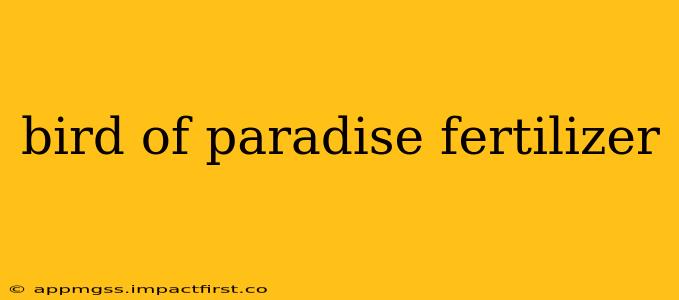The Bird of Paradise flower, with its vibrant, exotic blooms, is a coveted addition to any garden. However, these stunning plants have specific needs, and proper fertilization plays a crucial role in their health and abundant flowering. This guide will cover everything you need to know about fertilizing your Bird of Paradise, ensuring its long-term health and beauty.
What Kind of Fertilizer is Best for Bird of Paradise Plants?
Bird of Paradise plants thrive on a balanced diet, requiring a fertilizer rich in all essential nutrients – nitrogen (N), phosphorus (P), and potassium (K). A good general-purpose fertilizer with an NPK ratio of 10-10-10 or a similar balanced ratio is an excellent starting point. However, the specific needs may vary slightly depending on the plant's age and growth stage. Young plants might benefit slightly more from nitrogen to encourage vigorous foliage growth, while mature plants benefit from slightly higher phosphorus to promote abundant flowering. Avoid fertilizers high in nitrogen alone, as this can lead to excessive leaf growth at the expense of flowers.
How Often Should I Fertilize My Bird of Paradise?
The frequency of fertilization depends largely on the time of year and your plant's growth stage. During the active growing season (spring and summer), fertilize your Bird of Paradise every 2-4 weeks. Reduce the frequency to once a month or even less during the dormant period (fall and winter) when growth slows significantly. Always follow the instructions on the fertilizer packaging for the correct dilution rate. Over-fertilizing can be just as detrimental as under-fertilizing, leading to root burn and other problems.
How Often Should You Water a Bird of Paradise Plant?
Watering frequency is directly related to fertilization. Over-fertilizing combined with over-watering can severely damage your plant. Allow the top inch or two of soil to dry out between waterings, particularly during cooler months. During the growing season, more frequent watering may be necessary, depending on climate and pot size. Always ensure proper drainage to prevent waterlogging.
What are the Signs of Over-fertilization in Bird of Paradise Plants?
Over-fertilization can manifest in several ways. You might notice:
- Burnt leaf tips: Brown or crispy edges on the leaves.
- Salt buildup: White crust on the soil surface.
- Stunted growth: Ironically, over-fertilization can hinder growth.
- Leaf yellowing (chlorosis): Although this can also be a sign of nutrient deficiencies, it can be a consequence of excessive salts in the soil from over-fertilization.
If you suspect over-fertilization, immediately flush the soil with plenty of water to leach out excess salts. Avoid fertilizing for a few months to allow the plant to recover.
What are the Signs of Under-fertilization in Bird of Paradise Plants?
Under-fertilized Bird of Paradise plants typically exhibit:
- Pale green or yellowish leaves: Indicating a lack of essential nutrients.
- Slow growth: The plant will struggle to develop new leaves and flowers.
- Few or no flowers: Insufficient nutrients hinder flowering.
- Weak stems: The plant will lack the strength to support its growth and flowers.
What Type of Soil is Best for Bird of Paradise?
Well-draining soil is paramount for Bird of Paradise plants. A slightly acidic to neutral soil pH (around 6.0-7.0) is ideal. Amend heavy clay soils with organic matter like compost or peat moss to improve drainage.
Can I Use Organic Fertilizer for Bird of Paradise?
Yes, organic fertilizers are a great option for Bird of Paradise plants. Compost, worm castings, and other organic materials provide a slow-release source of nutrients, reducing the risk of over-fertilization. However, it's crucial to still monitor your plant's health and adjust feeding as needed.
When is the Best Time to Fertilize a Bird of Paradise Plant?
The best time to fertilize your Bird of Paradise is during its active growing season, typically spring and summer. This is when the plant is actively producing new growth and flowers, and therefore requires a greater supply of nutrients. Reduce or cease fertilizing during the dormant period (fall and winter).
By following these guidelines and paying close attention to your plant's needs, you can ensure your Bird of Paradise thrives and rewards you with its spectacular blooms year after year. Remember, consistent care, including appropriate fertilization and watering, is key to cultivating a healthy and vibrant plant.
